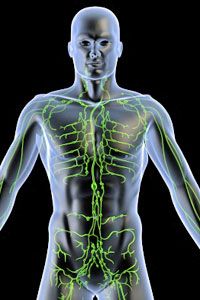The lymph system is the body's drainage system. It is composed of a network of vessels and small structures called lymph nodes. The lymph vessels convey excess fluid collected from all over the body back into the blood circulation. Along the way, however, these fluids are forced to percolate through the lymph nodes so that they can be filtered. Harmful organisms are trapped and destroyed by the specialized white blood cells, called lymphocytes, that are present in these nodes. Lymphocytes are also added to the lymph that flows out of nodes and back to the bloodstream.
Antibodies
Antibodies are manufactured by the lymph system. Antibodies are specialized proteins that the body produces in response to invasion by a foreign substance. The process of antibody formation begins when an antigen stimulates specialized lymphocytes, called B cells, into action. Antibodies then counteract invading antigens by combining with the antigen to render it harmless to the body.
Advertisement
Some antibodies coat the harmful organisms so that the body's scavenger cells can recognize and destroy them more easily. The antibody molecule combines with the antigen molecule by matching combining sites; they fit together like the pieces of a jigsaw puzzle. Other antibodies that neutralize toxins produced by bacteria are called antitoxins.
During periods of active antibody production, lymph nodes often enlarge and become tender to the touch. For example, a vaccination (injection of a natural or artificial antigen to stimulate the body to produce protective antibodies) in the arm can cause swelling of the nodes in the armpit, while mononucleosis causes enlargement of nodes that can be felt under the skin of the armpits, groin, and neck. The spleen (an organ located in the upper left part of the abdomen) is also important in the production of antibodies.
Advertisement

